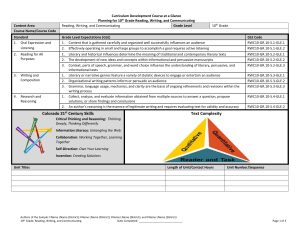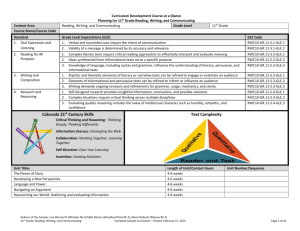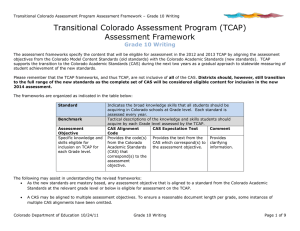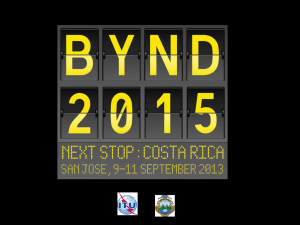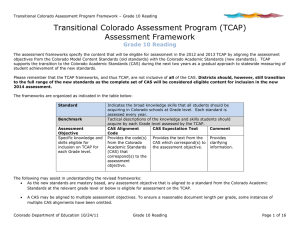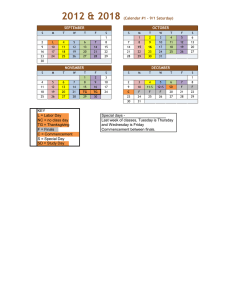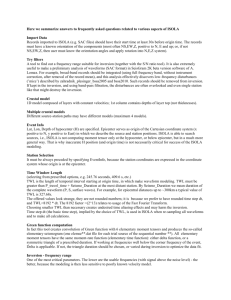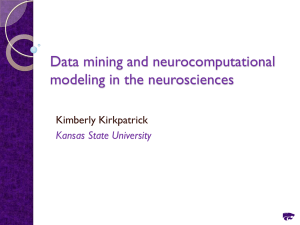Document 15590631
advertisement
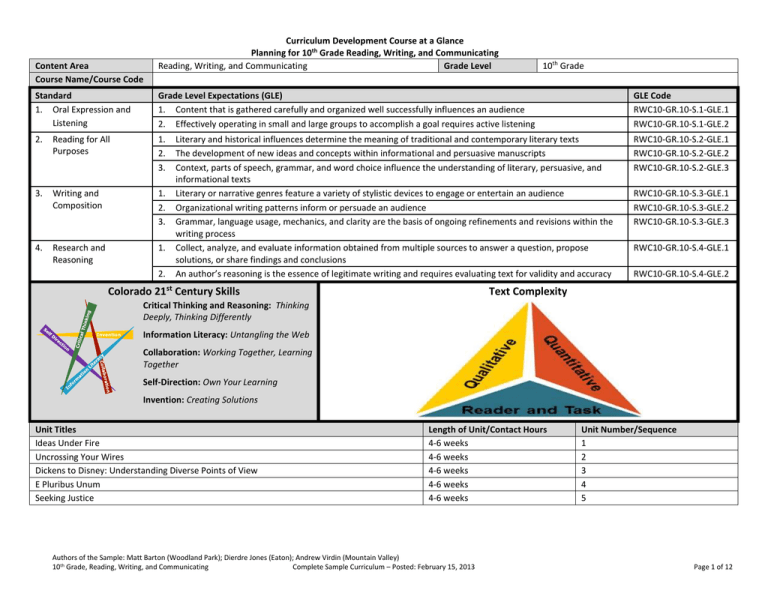
Content Area Course Name/Course Code Curriculum Development Course at a Glance Planning for 10th Grade Reading, Writing, and Communicating Reading, Writing, and Communicating Grade Level 10th Grade Standard 1. Oral Expression and Listening Grade Level Expectations (GLE) 1. Content that is gathered carefully and organized well successfully influences an audience 2. Effectively operating in small and large groups to accomplish a goal requires active listening GLE Code RWC10-GR.10-S.1-GLE.1 RWC10-GR.10-S.1-GLE.2 2. Reading for All Purposes 1. 2. 3. RWC10-GR.10-S.2-GLE.1 RWC10-GR.10-S.2-GLE.2 RWC10-GR.10-S.2-GLE.3 3. Writing and Composition 1. 2. 3. 4. Research and Reasoning 1. 2. Literary and historical influences determine the meaning of traditional and contemporary literary texts The development of new ideas and concepts within informational and persuasive manuscripts Context, parts of speech, grammar, and word choice influence the understanding of literary, persuasive, and informational texts Literary or narrative genres feature a variety of stylistic devices to engage or entertain an audience Organizational writing patterns inform or persuade an audience Grammar, language usage, mechanics, and clarity are the basis of ongoing refinements and revisions within the writing process Collect, analyze, and evaluate information obtained from multiple sources to answer a question, propose solutions, or share findings and conclusions An author’s reasoning is the essence of legitimate writing and requires evaluating text for validity and accuracy Colorado 21st Century Skills RWC10-GR.10-S.3-GLE.1 RWC10-GR.10-S.3-GLE.2 RWC10-GR.10-S.3-GLE.3 RWC10-GR.10-S.4-GLE.1 RWC10-GR.10-S.4-GLE.2 Text Complexity Critical Thinking and Reasoning: Thinking Deeply, Thinking Differently Invention Information Literacy: Untangling the Web Collaboration: Working Together, Learning Together Self-Direction: Own Your Learning Invention: Creating Solutions Unit Titles Ideas Under Fire Uncrossing Your Wires Dickens to Disney: Understanding Diverse Points of View E Pluribus Unum Seeking Justice Length of Unit/Contact Hours 4-6 weeks 4-6 weeks 4-6 weeks 4-6 weeks 4-6 weeks Authors of the Sample: Matt Barton (Woodland Park); Dierdre Jones (Eaton); Andrew Virdin (Mountain Valley) 10th Grade, Reading, Writing, and Communicating Complete Sample Curriculum – Posted: February 15, 2013 Unit Number/Sequence 1 2 3 4 5 Page 1 of 12 Curriculum Development Overview Unit Planning for 10th Grade Reading, Writing, and Communicating Unit Title Ideas Under Fire Focusing Lens(es) Perspectives (and change) Inquiry Questions (EngagingDebatable): Unit Strands Oral Expression and Listening, Reading for all Purposes, Writing and Composition, Research and Reasoning Concepts In content: In reading: In writing: Perspective, validation, information, change Appeals, style, tone, mood, claims, evidence, argument, perspective Appeals, style, tone, mood, claims, evidence, argument, perspective Length of Unit Standards and Grade Level Expectations Addressed in this Unit 4-6 weeks RWC10-GR.10-S.1-GLE.1 RWC10-GR.10-S.1-GLE.2 RWC10-GR.10-S.2-GLE.1 RWC10-GR.10-S.2-GLE.2 RWC10-GR.10-S.3-GLE.2 RWC10-GR.10-S.3-GLE.3 RWC10-GR.10-S.4-GLE.1 RWC10-GR.10-S.4-GLE.2 What effect does historical perspective have on understanding? (RWC10-GR.10-S.2-GLE.1-EO.d) and (RWC10-GR.10-S.2-GLE.2-EO.f) How does language affect understanding? (RWC10-GR.10-S.1-GLE.2-EO.a) and (RWC10-GR.10-S.3-GLE.3-EO.c) Does culture influence our point of view? (RWC10-GR.10-S.1-GLE.2-EO.b) and (RWC10-GR.10-S.2-GLE.2-EO.c) and (RWC10-GR.10-S.4-GLE.2-EO.a) In what ways are we biased? (RWC10-GR.10-S.1-GLE.2-EO.a) and (RWC10-GR.10-S.4-GLE.1-EO.d) Generalizations My students will Understand that… Guiding Questions Factual Conceptual Readers respond more insightfully to text by evaluating a speaker’s point of view. (RWC10-GR.10-S.1-GLE.2-EO.b) and (RWC10-GR.10-S.4-GLE.2-EO.b) How does the speaker’s point of view impact credibility? What are the clues to the speaker’s point of view? (RWC10-GR.10-S.2-GLE.2-EO.a) How does point of view impact credibility? In what ways does the reader’s point of view affect their understanding of a speaker? Opposing arguments require evaluation when assessing the accuracy of texts. (RWC10-GR.10-S.3-GLE.1-EO.a) and (RWC10-GR.10-S.2-GLE.2-EOb) What are the essential elements of the opposing arguments between these texts? (RWC10-GR.10S.2-GLE.2-EO.d) What are the logical components of these arguments? (RWC10-GR.10-S.4-GLE.1-EO.d; RWC10-GR.10-S.4GLE.2-EO.a) How is truth defined? (RWC0-9-GR.10-S.4-GLE.2-EO.b) What is the benefit of an opposing argument? How does truth and accuracy change over time? (RWC10-GR.10-S.1-GLE.2-EO.a) and (RWC10-GR.10S.4-GLE.1-EO.e) Author’s use rhetoric to persuade and enhance meaning. (RWC10-GR.10-S.1-GLE.2-EO.b) and (RWC10-GR.10-S.2GLE.3-EO.a) What are the rhetorical devices used in the text? (RWC10-GR.10-S.2-GLE-3-EO.a) and (RWC10-GR.10S.2-GLE.3.EO.b) How do the rhetorical devices affect the meaning? (RWC10-GR.10-S.2-GLE.2-EO.e) How do the meanings of words change over time? (RWC10-GR.10-S.2-GLE.1-EO.a) How is meaning impeded by faulty rhetoric? (RWC10GR.10-S.3-GLE.2-EO.a) and (RWC10-GR.10-S.4-GLE.1EO.d) Authors of the Sample: Matt Barton (Woodland Park); Dierdre Jones (Eaton); Andrew Virdin (Mountain Valley) 10th Grade, Reading, Writing, and Communicating Complete Sample Curriculum – Posted: February 15, 2013 Page 2 of 12 Curriculum Development Overview Unit Planning for 10th Grade Reading, Writing, and Communicating Effective appeals in arguments evince understanding of historical referents and literary significance. (RWC10GR.10-S.3-GLE.2-EO.a) and (RWC10-GR.10-S.2-GLE.2-EO.f) What is the historical context for this text? (RWC10GR.10-S.2-GLE.2-EO.f) and (RWC10-GR.10S.2_GLE.1-EO.e) What is the theme inherent in the author’s argument? (RWC10-GR.10-S.2-GLE.2-EO.d) How does the rhetorical structure lead to an effective argument? (RWC10-GR.10-S.4-GLE.2-EOa) and (RWC10-GR.10-S.3-GLE.2-EO.a) How do themes transcend time? (RWC10-GR.10-S.2GLE.2-EO.d) Critical Content: Key Skills: My students will Know… My students will be able to (Do)… Point of view ‘s relationship to historical context (RWC10-GR.10-S.1-GLE.2-EO.b) The markers of a weak argument (RWC10-GR.10-S.1-GLE.2-EO.b) The relationship between quality analysis and insight (RWC10-GR.10-S.2-GLE.2EO.b) Specific examples of seminal social/cultural documents (RWC10-GR.10-S.2-GLE.2EO.f) Arguments must be supported by the text (RWC10-GR.10-S.4-GLE.2-EO.b) The connections between personal growth/understanding and allowing our viewpoints to be challenged (RWC10-GR.10-S.4-GLE.2-EO.a) Establish credibility and enhance audience appeal (RWC10-GR.10-S.1-GLE.1-EO.c) Evaluate point of view (RWC10-GR.10-S.1-GLE.2-EO.b) Identify fallacious reasoning and distorted evidence (RWC10-GR.10-S.1-GLE.2EO.b) Respond to text insightfully (RWC10-GR.10-S.2-GLE.2-EO.b) Use text-based information to solve a problem not identified in the text (RWC10GR.10-S.2-GLE.2-EO.b) Analyze seminal U.S. documents (RWC10-GR.10-S.2-GLE.2-EO.f) Explain how writers use organization and details (RWC10-GR.10-S.3-GLE.2-EO.a) Cite text-based evidence (RWC10-GR.10-S.4-GLE.2-EO.b) Analyze opposing arguments (RWC10-GR.10-S.4-GLE.2-EO.a) Critical Language: includes the Academic and Technical vocabulary, semantics, and discourse which are particular to and necessary for accessing a given discipline. EXAMPLE: A student in Language Arts can demonstrate the ability to apply and comprehend critical language through the following statement: “Mark Twain exposes the hypocrisy of slavery through the use of satire.” A student in ______________ can demonstrate the ability to apply and comprehend critical language through the following statement(s): Although Thomas Jefferson and ___________ offer opposing arguments, both speak to transcendent themes. Seminal and historical documents contain relevance in modern society. Studying opposing arguments helps strengthen one’s own perspective. Academic Vocabulary: Appeal, Expert Authority, Credibility, Logic, Insight, Analysis, Assumptions, Primary and Secondary Sources, Opposition, Seminal, Reasoning Technical Vocabulary: Rhetoric, Dialogue, Pacing, Point of View Authors of the Sample: Matt Barton (Woodland Park); Dierdre Jones (Eaton); Andrew Virdin (Mountain Valley) 10th Grade, Reading, Writing, and Communicating Complete Sample Curriculum – Posted: February 15, 2013 Page 3 of 12 Curriculum Development Overview Unit Planning for 10th Grade Reading, Writing, and Communicating Unit Title Uncrossing Your Wires Focusing Lens(es) Inquiry Inquiry Questions (EngagingDebatable): Unit Strands Oral Expression and Listening, Reading for all Purposes, Writing and Composition, Research and Reasoning Concepts In content: In reading: In writing: Sources, research, inquiry, evidence, reason, beliefs Predict, infer, summarize, connections, evaluation Feedback, Word choice, Information Presentation, Sequencing, Style, Transitions, Conventions, revision Length of Unit Standards and Grade Level Expectations Addressed in this Unit 4-6 weeks RWC10-GR.10-S.1-GLE.1 RWC10-GR.10-S.1-GLE.2 RWC10-GR.10-S.2-GLE.1 RWC10-GR.10-S.2-GLE.3 RWC10-GR.10-S.3-GLE.1 RWC10-GR.10-S.3-GLE.2 RWC10-GR.10-S.3-GLE.3 RWC10-GR.10-S.4-GLE.1 RWC10-GR.10-S.4-GLE.2 How does media influence the questions we ask about an issue? (RWC10-GR.10-S.2-GLE.1-EO.b.e) and (RWC10-GR.10-S.2-GLE.2-EO.c) and (RWC10GR.10-S.4-GLE.1-EO.e) What is the value in seeking out arguments different from our own? (RWC10-GR.10-S.1-GLE.2-EO.a.b) and (RWC10-GR.10-S.3-GLE.2-EO.a.c) What questions are shared across cultures? (RWC10-S.1.GLE.2-EO.a) and (RWC10-S.2-GLE.1-EO.d) and ) RWC10-S.2-GLE.2-EO.c) How do we know which of our values are most important? (RWC10-GR.10-S.2-GLE.2-EO.d) and (RWC10-GR.10-S.4.GLE.1-EOg) Generalizations My students will Understand that… Guiding Questions Factual Conceptual Development of effective research questions and inquiry techniques leads to concise and appropriate presentation of information (RWC10-GR.10-S.1-GLE.1.EO.a) and (RWC10-GR.10-S.4-GLE.1-EO.c) Are these sources primary or secondary? What tells us that a thesis is narrow enough to focus research but broad enough to explore a thorough argument? (RWC10-GR.10-S.1-GLE.1-EO.a) and (RWC10-GR.10-S.4-GLE.1-EO.c) How is active listening effective in productive collaboration? (RWC10-GR.10-S.1-GLE.2-EO.a) Active listening aids effective collaboration by minimizing conflict and increasing understanding (RWC10-GR.10-S.1GLE.2-EO.a) and (RWC10-GR.10-S.1-GLE.2-EO.a) What insights were gained from listening to the feedback from others? (RWC10-GR.10-S.1-GLE.2EO.a) Why feedback is critical to the process of developing ideas? (RWC10-GR.10-S.1-GLE.2-EO.a) Source evaluation carefully considers the validity of the information presented. (RWC10-GR.10-S.4-GLE.1-EO.d) and (RWC10-GR.10-S.1-GLE-1-EO.a) Do the sources contain valuable information that is pertinent to research? Explain.(RWC10-GR.10-S.1GLE.2-EO.a) How does the quality of sources affect a presentation? Authors of the Sample: Matt Barton (Woodland Park); Dierdre Jones (Eaton); Andrew Virdin (Mountain Valley) 10th Grade, Reading, Writing, and Communicating Complete Sample Curriculum – Posted: February 15, 2013 Page 4 of 12 Curriculum Development Overview Unit Planning for 10th Grade Reading, Writing, and Communicating Attention to evidence promotes successful writing revision and clarity of purpose. (RWC10-GR.10-S.4-GLE.1EO.e) and (RWC10-GR.10-S.3-GLE.2-EO.a) Which words and evidence are essential to the argument and which ones need revision? How does revision add to effective arguments? (RWC10GR.10-S.4-GLE.1-EO.d) Effective writers and speakers solicit feedback to revise their ideas and writing. (RWC10-GR.10-S.1-GLE.2-EO.a) and (RWC10-GR.10-S.1-GLE.1-EO.e) How did the feedback improve thinking? What are the steps for effective proofreading? What are the elements in effective writing? (RWC10GR.10-S.4-GLE.1-EO.b) and (RWC10-GR.10-S.2-GLE.3EO.c) Critical Content: Key Skills: My students will Know… My students will be able to (Do)… The elements of composing effective literary techniques. (RWC10GR.10-S.3-GLE.1-EO.b) The difference between primary and secondary sources. (RWC10GR.10-S.2-GLE.1.EO.e) The ways in which a variety of evidence relate to the construction of an argument. (RWC10-GR.10-S.4-GLE.1-EO.e) The role of feedback in the revision process. (RWC10-GR.10-S.1GLE.1EO.e) The markers of quality research and their relationship to the creation of an effective argument. (RWC10-GR.10-S.4-GLE.1-EO.e) Use appropriate and varied transitions to link sections of text (RWC10-GR.10-S.3-GLE.2-EO.a) Create cohesion and clarify concepts among complex ideas. (RWC10-GR.10-S.3-GLE.2-EO.a) Create speeches or research using a range of stylistic devices. (RWC10-GR.10-S.3-GLE.1-EO.b) Distinguish between types of evidence (RWC10-GR.10-S.4-GLE.1-EO.e) Use research to support purpose (RWC10-GR.10-S.4-GLE.1-EO.e) Connect works to primary source documents. (RWC10-GR.10-S.2-GLE.1-EO.e) Determine and clarify meaning of words and phrases (RWC10-GR.10-S.3-GLE.3-EO.a) Choose words for intended audience (RWC10-GR.10-S.1-GLE.2-EO.a) Present information clearly, concisely and logically (RWC10-GR.10-S.1-GLE.1-EO.a) Use feedback to revise. (RWC10-GR.10-S.1-GLE.1-EO.e) Rehearse presentations (RWC10-GR.10-S.1-GLE.1-EO.b) Listen actively in collaborative groups (RWC10-GR.10-S.1-GLE.2-EO.a) Critical Language: includes the Academic and Technical vocabulary, semantics, and discourse which are particular to and necessary for accessing a given discipline. EXAMPLE: A student in Language Arts can demonstrate the ability to apply and comprehend critical language through the following statement: “Mark Twain exposes the hypocrisy of slavery through the use of satire.” A student in ______________ can demonstrate the ability to apply and comprehend critical language through the following statement(s): Based on sound research, which incorporated both sides of the argument, I believe whaling should be eliminated altogether. Academic Vocabulary: Cohesion, relationships, evidence, testimony, analogy, anecdote, statistics, primary/secondary sources, research, organization, development, Technical Vocabulary: Stylistic devices, figurative language, poetic techniques, imagery, theme, setting, phrasing, revision, tone Authors of the Sample: Matt Barton (Woodland Park); Dierdre Jones (Eaton); Andrew Virdin (Mountain Valley) 10th Grade, Reading, Writing, and Communicating Complete Sample Curriculum – Posted: February 15, 2013 Page 5 of 12 Curriculum Development Overview Unit Planning for 10th Grade Reading, Writing, and Communicating Unit Title Disney and Dickens: Understanding Diverse Points of View Focusing Lens(es) Diversity (universal themes) Inquiry Questions (EngagingDebatable): Unit Strands Oral Expression and Listening, Reading for all Purposes, Writing and Composition, Research and Reasoning Concepts In content: In reading: In writing: Diversity, Perspectives, Modes/mediums, Research, Equity, Fairness Analyze, deconstruct, synthesize, questioning, making connections, reflection Language/word choice, details, Topic development, sources, synthesis, revision, conclusion, support, clarity, voice, editing Standards and Grade Level Expectations Addressed in this Unit 4-6 Weeks Length of Unit RWC10-GR.10-S.1-GLE.1 RWC10-GR.10-S.1-GLE.2 RWC10-GR.10-S.2-GLE.1 RWC10-GR.10-S.2-GLE.2 RWC10-GR.10-S.3-GLE.1 RWC10-GR.10-S.3-GLE.2 RWC10-GR.10-S.3-GLE.3 RWC10-GR.10-S.4-GLE.1 Are there really a limited number of themes in the world? (RWC10-Gr.10-S.2-GLE.1-EO.d) What are some messages that may be conveyed using only nonverbal techniques? (RWC10-GR.10-S.1-GLE.1-EO.d) How do we know what we know? (RWC10-GR.10-S.4-GLE.1-EO.a) and (RWC10-GR.10-S.4-GLE.1-EO.b) and (RWC10-GR.10-S.4-GLE.1-EO.d) Generalizations My students will Understand that… Guiding Questions Factual Conceptual Diversity of perspectives can influence students’ understanding of the relationship between style and effect. (RWC10-GR.10-S.2-GLE.1-EO.g) How do these two artists use style and effect to create a diverse viewpoint? (RWC10-GR.10-S.1-GLE.2-EO.a) How do artists use style and effect to create diverse viewpoints? Knowledge of contextual language will enhance the personal revision process as writers seek to establish the validity of character and story components. (RWC10GR.10-S.3-GLE.3-EO.c) and (RWC10-GR.10-S.3-GLE.1-EO.d) What word choices strengthen a particular piece of writing and create credibility? How do artists select words and phrases to create credibility? When researching to solve a problem, a researcher must synthesize multiple sources.(RWC10-GR.10-S.4-GLE.1EO.a) What are the similarities and differences in these sources? What does a writer gain in using and synthesizing multiple sources? Various artistic media can provide diverse points of view to enhance a viewer’s understanding of an event. (RWC10-GR.10-S.2-GLE.1-EO.c) and (RWC10-GR.10-S.2GLE.2-EO.c) and (RWC10-GR.10-S.2-GLE.1-EO.b) What is the theme presented in each of these mediums? How are universal themes presented through differing mediums? Authors of the Sample: Matt Barton (Woodland Park); Dierdre Jones (Eaton); Andrew Virdin (Mountain Valley) 10th Grade, Reading, Writing, and Communicating Complete Sample Curriculum – Posted: February 15, 2013 Page 6 of 12 Curriculum Development Overview Unit Planning for 10th Grade Reading, Writing, and Communicating Critical Content: Key Skills: My students will Know… My students will be able to (Do)… Research concepts (RWC10-GR.10-S.4-GLE.1-EO.a) The writing process and steps to effective revision (RWC10-GR.10-S.3-GLE.1-EO.d) Different structures of various mediums (RWC10-GR.10-S.2-GLE.2-EO.c) and (RWC10-GR.10-S.2-GLE.1-EO.c) Key components of a medium (scenes, lines, images) (RWC10-GR.10-S.2-GLE.2EO.c) and (RWC10-GR.10-S.2-GLE.1-EO.c) Determine meaning of words and phrases in a text (RWC10-GR.10-S.2-GLE.1-EO.b) Construct research to solve problems (RWC10-GR.10-S.4-GLE.1-EO.a) Utilize precise language to manage topic complexity (RWC10-GR.10-S.3-GLE.2EO.a) Analyze various accounts by examining details and key scenes (RWC10-GR.10-S.2GLE.2-EO.c; RWC10-GR.10-S.2-GLE.1-EO.c) Identify various parts of speech to achieve understanding of the text (RWC10GR.10-S.2-GLE.1-EO.b) Develop a fact-based topic (quotations, details, extended definitions) (RWC10GR.10-S.3-GLE.2-EO.a) Explain relationship between author’s style and literary effect (RWC10-GR.10-S.2GLE.1-EO.g) Justify insightful response to diverse perspectives (RWC10-GR.10-S.1-GLE.2-EO.a) Critical Language: includes the Academic and Technical vocabulary, semantics, and discourse which are particular to and necessary for accessing a given discipline. EXAMPLE: A student in Language Arts can demonstrate the ability to apply and comprehend critical language through the following statement: “Mark Twain exposes the hypocrisy of slavery through the use of satire.” A student in ______________ can demonstrate the ability to apply and comprehend critical language through the following statement(s): The director of One Flew Over the Cuckoo’s Nest lost perspective, narrative voice, and viewer connection by choosing to omit The Chief’s internal point of view. Viewing “Breughel’s Landscape with the Fall of Icarus” alongside Auden’s poem, “Musee des Beaux Arts” enhances the viewer’s understanding of human isolation. Academic Vocabulary: Word choice, structure, short vs sustained research, medium, domain specific vocabulary, evaluation, creative, analyze, scene, technical, Technical Vocabulary: Phrase, clause, figurative vs. literal, connotation/denotation, tone, theme, genre, active/passive voice, style, literary effect, figurative language Authors of the Sample: Matt Barton (Woodland Park); Dierdre Jones (Eaton); Andrew Virdin (Mountain Valley) 10th Grade, Reading, Writing, and Communicating Complete Sample Curriculum – Posted: February 15, 2013 Page 7 of 12 Curriculum Development Overview Unit Planning for 10th Grade Reading, Writing, and Communicating Unit Title E Pluribus Unum Focusing Lens(es) Cultural Concepts (Heroism) Inquiry Questions (EngagingDebatable): Unit Strands Oral Expression and Listening, Reading for all Purposes, Writing and Composition, Research and Reasoning Concepts In content: In reading: In writing: Collaborate, culture, heroism, evidence, beliefs, values, expectations, relationships Diversity, influences, deconstruction, analysis, compare/contrast Editing, evidence, synthesizing, vocabulary, grammar 4-6 weeks Length of Unit Standards and Grade Level Expectations Addressed in this Unit RWC10-GR.10-S.1-GLE-1 RWC10-GR.10-S.1-GLE.2 RWC10-GR.10-S.2-GLE.1 RWC10-GR.10-S.2-GLE.2 RWC10-GR.10-S.2-GLE.3 RWC10-GR.10-S.3-GLE.1 RWC10-GR.10-S.3-GLE.2 RWC10-GR.10-S.3-GLE.3 RWC10-GR.10-S.4-GLE.1 How does language limit or add to our understanding of a story? (RWC10-GR.10-S.1-GLE.1-EO.b) and (RWC10-GR.10-S.2-GLE.1-EO.b) and (RWC10Gr.10-S.2-GLE.2-EO.e) and (RWC10-GR.1-S.2-GLE.3-EO.a) Which has greater value, the individual or the group? (RWC10-GR.10-S.1-GLE.2-EO.a) and (RWC10-GR.10-S.4-GLE.1-EO.a) How do stories reflect the beliefs of a culture? (RWC10-GR.10-S.2-GLE.1-EO.d) and (RWC10-GR.10-S.3-GLE.1-EO.a) and (RWC10-GR.10-S.3-GLE.2-EO.a) Generalizations My students will Understand that… Guiding Questions Factual Conceptual Collaboration around analysis of textual evidence allows students to examine and convey complex ideas. (RWC10GR.10-S.1-GLE.2-EO.a) and (RWC10-GR.10-S.3-GLE.2-EO.a) What figures of speech does the author use? (RWC10GR.10-S.2-GLE.3-EO.b) What does the author do to create the characters in this text? (RWC10-GR.10-S.2-GLE.1-EO.g) In what ways does the setting promote understanding? (RWC10-GR.10-S.2-GLE.1-EO.b) Why is collaboration important? (RWC10-GR.10-S.1GLE.2-EO.a) How can theme transcend time and place? (RWC10GR.10-S.2-GLE.1-EO.d) How does conflict reveal theme (s)? (RWC10-GR.10-S.2GLE.1-EO.f) Understand authors’ word choice, meaning and nuance can inform a student’s own narrative technique. (RWC10GR.10-S.2-GLE.3-EO.b) and (RWC10-GR.10-S.3-GLE.1EO.a) What is the difference between the connotative and denotative meanings within the text? (RWC10GR.10-S.2-GLE.2-EO.e) Which vocabulary/word choices impact the tone of the story? (RWC10-GR.10-S.2-GLE.3-EO.a) How does personal word choice affect meaning? (RWC10-GR.10-S.2-GLE.1-EO.b; RWC10-GR.10-S.2GLE.2-EO.a) How does word meaning change through time? (RWC10GR.1-S.2-GLE.2-EO.e; RWC10-GR.10-S.2-GLE.2-EO.f; RWC10-GR.1-S.2-GLE.3-EO.c) Authors of the Sample: Matt Barton (Woodland Park); Dierdre Jones (Eaton); Andrew Virdin (Mountain Valley) 10th Grade, Reading, Writing, and Communicating Complete Sample Curriculum – Posted: February 15, 2013 Page 8 of 12 Curriculum Development Overview Unit Planning for 10th Grade Reading, Writing, and Communicating The comparison of multiple texts can reveal the societal influences and cultural experiences of the author (RWC10-GR.10-S.1-GLE.2-EO.a; RWC10-GR.10-S.2-GLE.2EO.d) What societal values are seen in the main character? (RWC10-GR.10-S.2-GLE.2-EO.b) In comparing the two texts what are the cultural differences? (RWC10-GR.10-S.2-GLE.1-EO.c) and (RWC10-GR.10-S.2-GLE.2-EO.c) and (RWC10-GR.10S.2-GLE.2-EO.d) How does setting influence understanding of cultural values? (RWC10-GR.10-S.3-GLE.1-EO.a) What insights can be gained from the comparison of differing texts on the same topic? (RWC10-GR.10S.2-GLE.2-EO.d) and (RWC10-GR.10-S.4-GLE.2-EO.a) How does the story’s setting influence the author’s argument? (RWC10-GR.10-S.2-GLE.1-EO.e) and (RWC10-GR.10-S.2-GLE.1-EO.g) Collaborative discussions and the diversity they reveal aid individuals’ observational abilities. (RWC10-GR.10-S.2GLE.1-EO.d) and (RWC10-GR.10-S.3-GLE.1-EO.a) What current societal values are reflected within the text? (RWC10-GR.10-S.2-GLE.3-EO.a) and (RWC10GR.10-S.3-GLE.2-EO.a) What differences of ideas develop through your discussion? What benefit is derived from understanding different cultures? (RWC10-GR.10-S.1-GLE.2-EO.a) How does discussion of diverse cultures help us better understand our own perspectives? How do cultural values influence our reading of the text? (RWC10-GR.10-S.2-GLE.2-EO.b) and (RWC10-GR.10S.4-GLE.1-EO.g.i) Critical Content: Key Skills: My students will Know… My students will be able to (Do)… Narrative effects and outcomes that result from either the writer’s real or imagined experience(s) (RWC10-GR.10-S.3-GLE.1-EO.a) Good discussions’ relationship to textual evidence (RWC10-GR.10-S.1-GLE.2-EO.a) The technological devices or programs to aid writing (RWC10-GR.10-S.3-GLE.3EO.f) Fundamentals of grammar and writing (RWC10-GR.10-S.3-GLE.3-EO.a & b) Word meaning using context or resources (RWC10-GR10-S.2-GLE.3-EO.b) The methods of reading for different purpose(s) and understanding(s) (RWC10GR.10-S.2-GLE.2-EO.g) Come to discussion prepared; read and research material; refer to evidence from text (RWC10-GR.10-S.1-GLE.2.a) Determine meaning of words and phrases; analyze impact of word choice (RWC10GR.10-S.2-GLE.1-EO.b) Read and comprehend literary non-fiction (RWC10-GR.10-S.2-GLE.2-EO.g) Analyze nuance in word meaning with similar denotation (RWC10-GR.10-S.2-GLE.3EO.b) Interpret figures of speech and analyze their role in the text (RWC10-GR.10-S.2GLE.3-EO.b) Write a developed narrative based upon experience or events (RWC10-GR.10-S.3GLE.1-EO.a) Write an informative text (RWC10-GR.10-S.3-GLE.2-EO.a) Demonstrate command of standard English and conventions (RWC10-GR>10-S.3GLE.3-EO.a & b) Produce clear and coherent writing (RWC10-GR.10-S.3-GLE.3-EO.d) Use technology to produce writing (RWC10-GR.10-S.3-GLE.3-EO.f) Authors of the Sample: Matt Barton (Woodland Park); Dierdre Jones (Eaton); Andrew Virdin (Mountain Valley) 10th Grade, Reading, Writing, and Communicating Complete Sample Curriculum – Posted: February 15, 2013 Page 9 of 12 Curriculum Development Overview Unit Planning for 10th Grade Reading, Writing, and Communicating Critical Language: includes the Academic and Technical vocabulary, semantics, and discourse which are particular to and necessary for accessing a given discipline. EXAMPLE: A student in Language Arts can demonstrate the ability to apply and comprehend critical language through the following statement: “Mark Twain exposes the hypocrisy of slavery through the use of satire.” A student in ______________ can demonstrate the ability to apply and comprehend critical language through the following statement(s): Beowulf reflects the values of Anglo-Saxon culture through his actions and speech. A Classic Hero reflects his or her societal values through both action and speech. The heroic archetype demonstrates themes that are universal throughout literature and cultures. Academic Vocabulary: Analyze, Diversity, Interpret, Apply, Culture, Value, Inferences, Conventions and Grammar, Society, Technology, Observation, Collaboration, Nuance, Evidence Technical Vocabulary: Classic Hero, Tragic Hero, Epic, Quest, Archetype, Plot, Hubris, Catharsis, Hamartia, Characterization, Climax, Setting, Exposition, Rising Action, Denouement, Resolution, Irony, Motif, Symbol, Theme, Conflict, Foil, Antagonist, Protagonist, Connotation, Denotation, Figurative Language, Tone, Narrative, Euphemism, Figures of Speech Authors of the Sample: Matt Barton (Woodland Park); Dierdre Jones (Eaton); Andrew Virdin (Mountain Valley) 10th Grade, Reading, Writing, and Communicating Complete Sample Curriculum – Posted: February 15, 2013 Page 10 of 12 Curriculum Development Overview Unit Planning for 10th Grade Reading, Writing, and Communicating Unit Title Seeking Justice Focusing Lens(es) Justice/Power Inquiry Questions (EngagingDebatable): Unit Strands Oral Expression and Listening, Reading for all Purposes, Writing and Composition, Research and Reasoning Concepts In content: In reading: In writing: Justice, fairness, validity, reasoning, criticism, evidence, listening, proof, collaboration Inference, discussion, evaluation, predicting, analysis, Rhetoric, precision, word choice, language, editing, citations, narrative techniques, Length of Unit Standards and Grade Level Expectations Addressed in this Unit 4-6 weeks RWC10-GR.10-S.1-GLE.1 RWC10-GR.10-S.1-GLE.2 RWC10-GR.10-S.2-GLE.1 RWC10-GR.10-S.2-GLE.2 RWC10-GR.10-S.2-GLE.3 RWC10-GR.10-S.3.GLE.1 RWC10-GR.10-S.3-GLE.3 RWC10-GR.10-S.4-GLE.1 Why do some authors feel compelled to be social critics? (RWC10-GR.10-S.2-GLE.2-EO.f) and (RWC10-GR.10-S.3-GLE.2-EO.a) and (RWC10-GR.10-S.4GLE.1-EO.a) Are there a limited number of themes in the world? (RWC10-GR.10-S.2-GLE.1-EO.d) and (RWC10-GR.10-S.2-GLE.2-EO.d) How can two works differ and be valid at the same time? (RWC10-GR.10-S.1-GLE.1-EO.c) and (RWC10-GR.10-S.2-GLE.1-EO.c) and (RWC10-GR.10-S.4GLE.2-EO.a) Generalizations My students will Understand that… Guiding Questions Factual Conceptual An author’s social commentary creates themes they hope will transcend culture and time (RWC10-GR.10-S.2-GLE.1EO.d) and (RWC10-GR.10-S.1-GLE.2-EO.a) What lessons from the text are relevant today (e.g. Night)? What are the cross-cultural elements inherent in genocide? What is the role of the artist within society? Clear, goal oriented agendas create purposeful collaborative discussions and writing conferences (RWC10-GR.10-S.1-GLE.2-EO.a) and (RWC10-GR.10-S.3GLE.3-EO.e) What elements of the agenda were met in the discussion? How is peer editing beneficial to the writing process? How does group discussion illuminate existing themes in comparative texts? Textual evidence should drive thematic discussions (RWC10-GR.10-S.1-GLE.2-EO.a) and (RWC10-GR.10-S.2GLE.2-EO.d) In discussing _______and ________ what themes are evident in both? How is specific evidence important to understanding the theme? Clear rhetoric and precise vocabulary enable valid reasoning (RWC10-GR.10-S.4-GLE.1-EO.g) and (RWC10GR.10-S.1-GLE.1-EO.b) Does the conclusion match the thesis? How would more effective vocabulary improve the argument? In what ways does reasoning and rhetoric strengthen an argument? (RWC10-GR.10-S.3-GLE.1-EO.a) Authors of the Sample: Matt Barton (Woodland Park); Dierdre Jones (Eaton); Andrew Virdin (Mountain Valley) 10th Grade, Reading, Writing, and Communicating Complete Sample Curriculum – Posted: February 15, 2013 Page 11 of 12 Curriculum Development Overview Unit Planning for 10th Grade Reading, Writing, and Communicating Critical Content: Key Skills: My students will Know… My students will be able to (Do)… Specific ways in which authors contribute to society through literature (RWC10GR.10-S.2-GLE.1-EO.d) Ideas and concepts manifest across multiple texts (RWC10-GR.10-S.2-GLE.2.-EO.d) The relationship between effective reading and the drawing of inferences (RWC10GR.10-S.2-GLE.3-EO.a) Various and diverse reference materials for idea validation (RWC10-GR.10-S.2GLE.3-EO.a) Different organizational patterns necessary for varied writing purposes (RWC10GR.10-S.1-GLE.1-EO.b) Collaborative discussion role in idea development and refinement (RWC10-GR.10S.1-GLE.2-EO.b) Evaluate contribution to society made by traditional, classic, and contemporary works of literature (RWC10-GR.10-S.2-GLE.1-EO.d) Compare the development of an idea or concept in multiple texts (RWC10-GR.10S.2-GLE.2-EO.d) Comprehend literature and non-fiction at the high end of 9-10 (RWC10-GR.10-S.2GLE.1-EO.h) Verify inferences of word and phrase meaning (RWC10-GR.10-S.2-GLE.3-EO.a) Consult reference materials to verify meaning (RWC10-GR.10-S.2-GLE.3-EO.a) Select organizational patterns and structures (RWC10-GR.10-S.1-GLE.1-EO.b) Initiate, propel, facilitate, and contribute to discussions (RWC10-GR.10-S.1-GLE.2EO.a) Use parenthetical citations to document sources (RWC10-GR.10-S.4-GLE.1-EO.f) Create a well organized analysis and use a variety of strategies to evaluate whether writing is presented well. (RWC10-GR.10-S.3-GLE.2-EO.a) and (RWC10-GR.10-S.3GLE.1-EO.c) Critical Language: includes the Academic and Technical vocabulary, semantics, and discourse which are particular to and necessary for accessing a given discipline. EXAMPLE: A student in Language Arts can demonstrate the ability to apply and comprehend critical language through the following statement: “Mark Twain exposes the hypocrisy of slavery through the use of satire.” A student in ______________ can demonstrate the ability to apply and comprehend critical language through the following statement(s): Huckleberry Finn expresses many of the principles found in Thoreau’s Civil Disobedience. Wiesel’s narrative of The Holocaust can be reflected in the accounts of displacement and genocide seen in contemporary non-fiction. Academic Vocabulary: Analysis, reasoning, evidence, society, justice, classic, contemporary, evidence, inference, reference materials, organization, collaboration, persuasion, conclusions, facilitate, active listening Technical Vocabulary: Dictionary, glossary, thesaurus, etymology, theme, symbolism, genre , motif, plot, characterization, imagery Authors of the Sample: Matt Barton (Woodland Park); Dierdre Jones (Eaton); Andrew Virdin (Mountain Valley) 10th Grade, Reading, Writing, and Communicating Complete Sample Curriculum – Posted: February 15, 2013 Page 12 of 12
